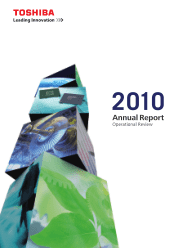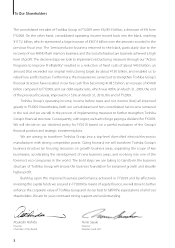Toshiba 2010 Annual Report Download - page 11
Download and view the complete annual report
Please find page 11 of the 2010 Toshiba annual report below. You can navigate through the pages in the report by either clicking on the pages listed below, or by using the keyword search tool below to find specific information within the annual report.In FY2009, to enhance the fi nancial strength of Toshiba Group and allow it to
have the financial foundation to pursue further growth opportunities, you
decided to increase Toshiba’s shareholders’ equity through equity finance.
What has Toshiba Group done to strengthen its financial soundness for
FY2010?
With the improvement in Toshiba Group’s business results and our successful procurement of
additional capital funds, our shareholders’ equity ratio, which was 8% at the end of FY2008,
increased to 15% at the end of FY2009; our debt/equity (D/E) ratio, which was 405% at the end
of FY2008, improved to 153% at the end of FY2009; and our return-on-investment (ROI) ratio
moved from -10% at the end of FY2008 to +5% at the end of FY2009. Our efforts to establish a
financial structure to support sustained growth with steadily higher profit are beginning to
show good results. However, we firmly intend to make a great transition to a more powerful
financial structure between now and the end of FY2012. We will continuously endeavor to
further build up our financial structure through such measures as the strengthening of our
earnings power and the shortening of the cash conversion cycle. In particular, with regard to
investments aimed toward future growth, we have newly introduced a set of in-company,
comprehensive investment controls designed to fit with the characteristics of each business.
We will make investments based on a careful selection process and will measure and evaluate
their actual effectiveness. To maintain superior competitiveness, we will systematically prepare
and consider each business case and then proceed to carry out business operations while
placing emphasis on the rate of return-on-investment as an important criterion for
management.
How do you intend to reshape the business structure of Toshiba Group?
As a result of the restructuring measures we have been implementing, we have been able to
make progress in the strengthening of our profi t foundation. In the future, in addition to these
achievements, I believe that the transforming of our business structure is necessary so as to
transform Toshiba Group into a top-level diversified electric/electronics manufacturer with a
strong global competitive power that will allow us to achieve sustained growth, which surpasses
that of our market peers, and to attain steadily higher profi t. Concretely put, Toshiba’s mid- to
long-term transformative strategic vision is that by focusing on growth business areas,
expanding the scope of key businesses, accelerating the development of new business areas,
evolving into a foremost global eco-company and contributing to the future of a sustainable
planet Earth we will assure that we have a steady, strong and profi table business structure that
has enormous possibilities for generating powerful growth and stellar earnings.
You might want to ask the question about why business structure change is necessary now.
The answer is that in the emerging economies, the strength of the consumer market has grown
Q.
A.
Q.
A.
TOSHIBA Annual Report 2010 9
























